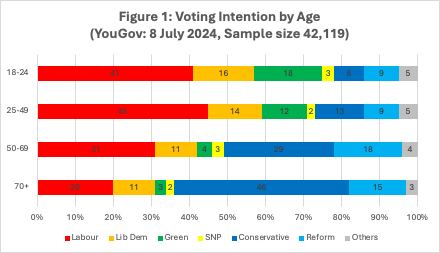
Prof James Sloam
Professor of Politics at Royal Holloway, University of London. His research focuses youth civic and political engagement in the UK, Europe and the US (Springer 2019), and the real and potential impact of youth voice on public policy (UN 2023; Policy and Politics 2024).
Email: James.Sloam@rhul.ac.uk

Prof Matt Henn
Emeritus Professor (retired) of Social Research in the Department of Social and Political Sciences at Nottingham Trent University. His research focuses on youth, citizenship and political participation.
Email: matt.henn@ntu.ac.uk

UK Election 2024
Section 2: Voters, polls and results
13. Forecasting a multiparty majoritarian election with a volatile electorate (Dr Hannah Bunting)
14. The emerging infrastructure of public opinion (Dr Nick Anstead)
15. A moving target? Voter segmentation in the 2024 British General Election (Prof Rosie Campbell)
16. Don’t vote, it only encourages them? Turnout in the 2024 Election (Prof Charles Pattie)
17. Cartographic perspectives of the 2024 General Election (Prof Benjamin Hennig)
18. Gender and vote choice: early reflections (Dr Ceri Fowler)
19. Changing Pattern amongst Muslim voters: the Labour Party, Gaza and voter volatility (Dr Parveen Akhtar)
20. Religion and voting behaviour in the 2024 General Election (Dr Ekaterina Kolpinskaya, Dr Stuart Fox)
21. Failure to connect: the Conservative Party and young voters (Dr Stephanie Luke)
22. Youthquake for the progressive left: making sense of the collapse of youth support for the Conservatives (Prof James Sloam, Prof Matt Henn)
23. Values in the valence election (Prof Paula Surridge)
24. Tactical voting: why is it such a big part of British elections? (Thomas Lockwood)
The 2024 UK General Election marked an historic defeat for the Conservative Party, which was driven by supercharged support amongst younger generations of voters for progressive left parties (Labour, Liberal Democrats, Greens, SNP and Plaid). The Conservatives scored only an estimated 8% amongst young adults (18-24 year-olds) and 13% for 25-49s, compared to 46% of those aged 70-plus (Figure 1).

In our previous report for this election series and in our 2019 Youthquake book, we observed that in recent elections, age has become a key dividing line, with young people tending to vote for centre-left and social liberal parties – significantly more so than their older contemporaries. Whilst this trend is true for most established democracies, we revealed this was particularly pronounced in Britain, with the country’s youth voting for Labour at more than double the rate of the wider electorate at #GE2017 and #GE2019. This shift is historically unprecedented.
We also identified the importance of intragenerational trends – within-youth differences based on gender, ethnicity, social class, and education. For example, young women and students have now become much more likely to vote for progressive causes and parties than young males and non-students.
Youthquake for the progressive left in 2024
Figure 1 reveals that 79% of 18-24s supported progressive left parties at #GE2024, including 41% lining-up behind Labour. By comparison, only 17% of young people voted Conservative (8%) or Reform (9%). The 2024 pattern for the 25-49 year-old group was surprisingly similar. Labour secured 45%, with 73% for all progressive parties; the combined Conservative/ Reform vote (22%) was only marginally higher than for 18-24s. The levels of support for these two right-wing parties were significantly higher amongst 50-69s (47%) and 70-plus (61%).
The 2024 intragenerational rates of youth support for the progressive parties produced some equally striking results. Young women and young men aged 18-24 supported Labour in similar proportions (42%:40%). However, the total support for the progressive left parties amongst young women (84%) was noticeably higher than for young men (72%). Similarly, 82% of students supported these parties.
Serving young people – the absence of youth issues
There was also a dramatic drift of young people away from the two larger parties between #GE2019 and #GE2024. Firstly, the Conservative’s 2019 youth support of 20% dropped to 8% in 2024 in a low turnout election (we estimate that less than half of registered 18-24s voted). Whilst Labour’s youth support remained strong in 2024, it contracted by 15 points from 56% in 2019. Indeed the combined youth Labour-Conservative support fell overall from over three-quarters (76%) in 2019 to under a half (49%) in 2024.
During the course of the 2024 campaign period, there was also a noticeable “spreading-out” of Labour’s youth vote (particularly amongst women) away from Starmer’s centrist and cautious party positioning. YouGov pre-election campaign polls traced this movement, with Labour’s 57% of youth support at the start of the campaign, falling 16 points by polling day.
This drop in Labour’s support corresponds with their repeated election campaign pronouncements to commit to working within the Conservative’s spending constraints and their relative silence on youth issues. It reflects a relative failure to effectively address young people’s issues – including mental health, housing, university tuition fees, and environmental matters. Under former Labour leader Jeremy Corbyn in #GE2017 and #GE2019, there was a deliberate effort to court the youth vote and appeal to youth issues, but such efforts to mobilise young people were largely absent from Keir Starmer’s much more centrist agenda in #GE2024.
Examination of Labour’s #GE2024 election manifesto reveals that it offered several policy commitments that combined, might improve young people’s economic and social well-being and appeal somewhat to their youth-specific priorities. For instance, it pledged to set-up a publicly-owned Great British Energy and create 650,000 ‘green’ jobs – which arguably would have resonated with many young people’s aspirations concerning the climate crisis. It also outlined a youth guarantee of access to training, apprenticeships and employment support, Young Futures hubs, and votes for 16- and 17-year-olds in general elections.
However, these youth-friendly promises were given little prominence during the pre-election period. Instead, ‘mainstream’ issues as taxation, immigration, and the NHS largely dominated the pre-election discourse. This lack of focus on youth policy areas was even noted by Alistair Campbell, former Director of Communications to Tony Blair, who commented on the need for the party to show young people what they are going to deliver for them.
Concluding observations
It is perhaps not surprising that in the context of Labour’s relative lack of commitment to specifically youth-oriented policies, alongside muted youth engagement, communication and mobilisation strategies, the verdict of many young people at #GE2024 was of some disappointment, many abstaining from voting or switching to other progressive left parties. Youth support for Labour at the start of the campaign proved to be very shallow – a mile wide but an inch deep. Although Labour secured a stunning electoral landslide, it cannot rely on this group remaining loyal without meaningful commitments to youth priorities in government. Otherwise, young people may become even more disillusioned with electoral politics, leading to lower turnout and an increase in alternative forms of political activism, as well as the potential for them to be drawn towards populist parties and causes.
